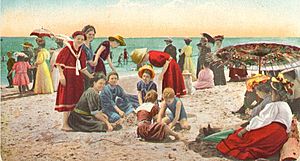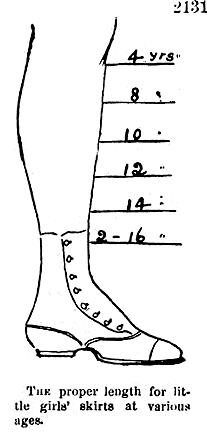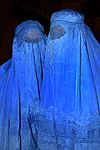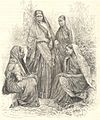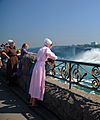Modesty facts for kids
Modesty is about how people behave and dress in a way that is respectful and doesn't draw too much attention to themselves. It's like following unwritten rules about what's appropriate in different situations. These rules can be different depending on where you live or what group you belong to.
Modesty often includes:
- Not trying to be the center of attention.
- Wearing clothes that fit in with what most people wear.
- Not bragging about your achievements (this is called humility).
What is considered modest can change over time, like with different fashion trends. People also often feel peer pressure to follow these rules. The level of modesty expected can also change based on the situation or the people involved.
Contents
When Modesty Rules Don't Apply
Modesty is a social rule, but it doesn't apply in every situation. For example, in an emergency, it's more important for doctors to help people who are wounded. In such cases, modesty might take a backseat to safety and health.
However, some people still try to keep their personal modesty standards, even during an emergency.
Modesty for Different Groups
Modesty often suggests that certain parts of the human body should be covered. This usually means covering bare skin or undergarments. Sometimes, the rules also say that clothes should hide the shape of the body, not just cover it. There are also rules about how to change clothes, like using a towel at the beach or locking a door.
Different cultures have different ideas about modesty. What's considered modest also depends on who might see you:
- Your spouse or partner.
- A friend or family member of the same gender.
- Family members of the opposite gender.
- A friend of the opposite gender.
Sometimes, people can be too modest. This is often called prudishness.
Modesty in Religions
Many religions have ideas about modesty, especially regarding how people dress.
Islam and Modesty
In Islam, modesty is very important. However, there are different ways people interpret what modest dress means. Many Muslim women wear a headscarf (hijab) to show modesty. In some stricter societies, women are expected to cover their whole body, except for their hands and face.
Some women choose to cover their face and hands as well, which they see as a deeper sign of modesty. In some Islamic countries, women wear a niqab, which covers almost the entire body, sometimes even the eyes. The niqab is sometimes called a burqa, though a burqa is a specific type of full-body garment from Afghanistan.
In most Muslim countries, women can choose how they express their modesty. But in some countries, like Afghanistan or Iran, there are laws about what women must wear. Not following these laws can lead to serious consequences.
For men in Islam, some interpretations say they should cover from their belly button to their knees. Some men also wear a traditional Islamic head covering called a taqiyah (cap). This cap is similar to the Jewish yarmulke but is usually a bit larger. The taqiyah can come in different shapes, sizes, and colors, depending on local traditions.
A burqini is a special swimsuit for Muslim women. It covers the whole body except the face, hands, and feet. This allows them to swim while still following Muslim modesty rules.
Judaism and Modesty
Modesty is also important in Judaism, especially for women. In some very traditional Jewish communities, like Orthodox and Hasidic groups, married women are expected to cover their hair in public. They might use a scarf, hat, snood, or a wig (called a "sheitel").
Some communities have even stricter rules. They expect women to cover their elbows and legs. Blouses should cover the collarbone, and sleeves should cover the elbows. Skirts are expected to cover the knees, and any slits in skirts should be closed. Clothes should not be see-through, too tight, or have very bright colors or loud texts. Some communities apply these rules to girls as young as three years old.
More modern Orthodox Jewish women might wear a small scarf or hat to cover the top of their head, allowing some hair to show. Jewish women who are not Orthodox usually follow the fashion trends of the society they live in.
Catholic Christianity
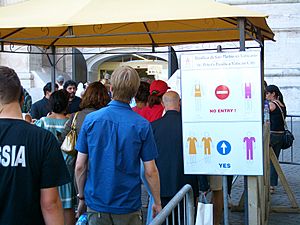
Catholics are also expected to dress modestly, though there are no strict official rules. Sometimes, priests and popes have shared their opinions on what modest dress means. While these opinions are not strict laws, many Catholics find them helpful.
For example, Pope Pius XII once suggested that women should cover their upper arms and shoulders. He also said that skirts should reach at least the knee, and necklines should not be too revealing. The Church also expects men to dress modestly.
Images for kids
-
Three Ukrainian men in swim trunks in Cox's Bazar, Bangladesh. Their swimwear might be seen as immodest compared to local customs.
-
Amish women on an American beach in 2007. Their plain dress shows how modesty in clothing can be different across cultures, even in the West.
-
Buddhist monks visiting the Hindu-Buddhist temple complex Angkor Wat in Cambodia, dressed in their traditional modest robes.
-
An engraving from 1869 showing Christian women in India.
-
An Anabaptist Christian woman wearing a cape dress and headcovering at Niagara Falls.
See also
 In Spanish: Pudor para niños
In Spanish: Pudor para niños


